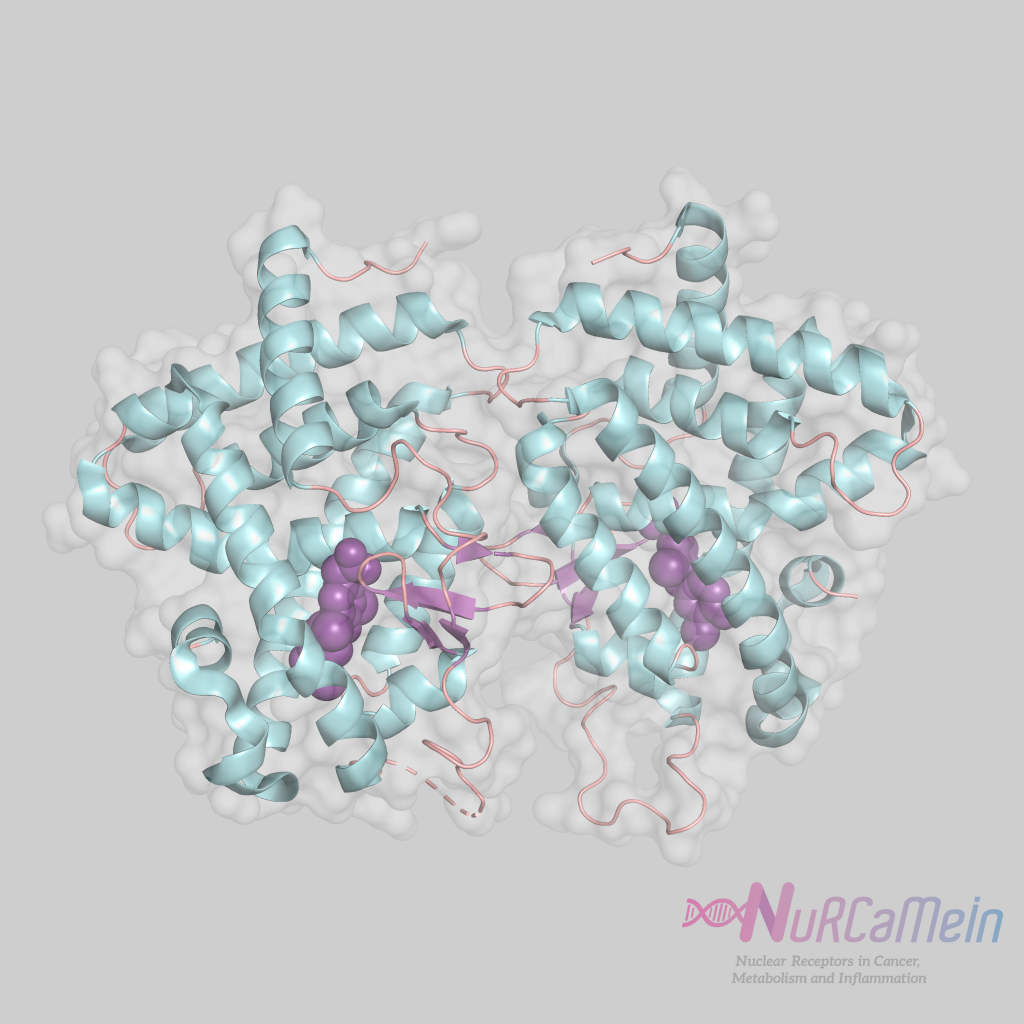TR (THYROID HORMONE RECEPTOR)
Thyroid hormone receptors (TRs) are transcription factors that are activated in the presence of their ligand (thyroid hormone, or TH). Their union causes the separation of corepressors and the recruitment of coactivators, with the consequent regulation of gene expression.
Ligands
The main ligands of TRs are thyroid hormones (TH) T4 and T3, with a higher binding affinity for T3.
TRs can also be activated by certain endogenous and synthetic molecules, which induce active receptor conformations involved in thyroid hormone-dependent signaling pathways.
Classification
Thyroid hormone receptors (TRs) are members of the NR1 subfamily, of the large nuclear receptor superfamily (NRs), along with other receptors such as RAR, VDR, PPAR or LXR.
In turn, based on their affinity for the ligand and its mode of action, they are classified as “endocrine” and Type I receptors.
Structure and interactions
TRs have the typical nuclear receptor structure. The NTD (N-terminal transactivation) domain varies among the different isoforms. The DNA-binding domain (DBD) is highly conserved and contains two “zinc fingers” that interact with the thyroid hormone response elements (TREs) of DNA. The ligand-binding domain (LBD, in C-terminal) is comprised of twelve amphipathic helices, some of which specifically interact with coactivators and corepressors.

TR structure
In the absence of thyroid hormone (TH), TRs bind to TRE preferentially in the form of heterodimers with X retinoid receptors (RXRs), associated with corepressors that suppress basal transcriptional activity.
In the presence of TH, binding to TR modifies the conformation of the LBD region of the receptor, which causes the release of corepressors and the recruitment of coactivators, modifying the structure of chromatin and facilitating transcriptional activation of target genes.
Expression
The main active variants of the two alpha (TRα) and beta (TRβ) isoforms of TRs are expressed in:
- TR-α1: in most tissues, mainly heart and skeletal muscle, bones, brown fat, brain and kidneys.
- TR-β1: in most tissues, preferably liver, brain and kidney.
- TR-β2: in the hypothalamus, anterior pituitary gland and in the developing brain.
Main functions
Among the most important functions of TRs are the regulation of metabolism and of cardiac frequency, contractility and relaxation.
Furthermore, they play a crucial role in the growth and development of organisms.
TRs in the NuRCaMeIn Network
- Laboratorio de Ana Aranda | Departamento de Fisiopatología Endocrina y del Sistema Nervioso del Instituto de Investigaciones Biomédicas “Alberto Sols”, Centro Mixto del Consejo Superior de Investigaciones Científicas y la Universidad Autónoma de Madrid.
- Pathophysiology of Thyroid Hormone Receptors | Nurcamein
- Instituto de Biomedicina de la UB (IBUB) | Universidad de Barcelona
- Molecular Structure of Nuclear Receptors | Nurcamein
References
- Role of thyroid receptor β in lipid metabolism, Camilla Pramfalk et al. | Biochimica et Biophysica Acta (BBA) – Molecular Basis of Disease
- Thyroid Hormone Receptors, Claire Briet et al. | Encyclopedia of Endocrine Diseases (Second Edition)
- Alternative ligands for thyroid hormone receptors, Iván Lazcano et al. | Molecular and Cellular Endocrinology
- Neuroendocrine Regulation of Development, Growth and Metabolism – Thyroid, R. Thomas Zoeller et al. | Handbook of Neuroendocrinology
- Receptores nucleares: del núcleo al citoplasma, Bibiana Ortega Domínguez et al. | TIP, Revista especializada en Ciencias Químico-Biológicas
